Despite general irritation with any exciting new higher education concept which entails a prefix such as ‘micro-‘ or ‘nano-‘ I was interested in this recent report in the Chronicle on the rise of the ‘micro-campus’:
As education moves online and colleges seek new ways of interacting with students, alumni, local communities, and other constituencies, institutions as diverse as the University of Phoenix, the University of Washington, and the Georgia Institute of Technology are responding with experimental, storefront-sized “microcampuses.” They’re also looking at unexpected models — such as Amazon’s bricks-and-mortar stores — for ideas to improve students’ experience.
The spaces, some located on the ground floors of apartment buildings or commercial high-rises, give the institutions public visibility while providing stylish drop-in spaces for students. They can also be focal points for colleges’ educational and outreach activities with local employers and community groups.
So far, so novel. These really do sound rather like cool cafes, with decent wifi and some university branding. Instead of WeWork it is a bit like WeStudy (although I think that name is probably already taken).

But the University of Arizona has really thought this through in rather more detail and now has an international network of such locations which in its case are located on the campus of a partner university where they deliver degrees collaboratively. Some of the features according to the university include:
SHARED CAMPUS – The partner university allows the use of its physical campus and classrooms, and provides a designated space for the UA, which alleviates the need for new infrastructure and allows the UA to focus on delivering high-quality educational instruction in collaboration with the partner university.
SHARED STUDENTS – Students maintain their student status at the partner university while enrolled in the for-credit UA courses offered on location at the partner university.
COLLABORATIVE TEACHING – Courses are offered in-person and co-taught by a UA professor and a local professor, or a locally-based UA faculty member.
RESEARCH INCUBATION – Micro-campuses serve as hubs for faculty collaboration and capacity building, including joint research and grant proposals.
DUAL DEGREES – Students earn a UA degree and a degree from the partner university, including bachelor’s and master’s-level degree options across multiple disciplines.
MOBILITY OPTIONS – Partner university students can study at the UA Main Campus in Tucson or any location within the UA Global Micro-campus Network.
It’s all very exciting and different (sort of) and the universities named in Goldie’s report do seem to be exploring some novel outreach approaches. Will it catch on though? And how long will it be before someone comes up with the idea for a nano-campus (which is really just a desk)?












